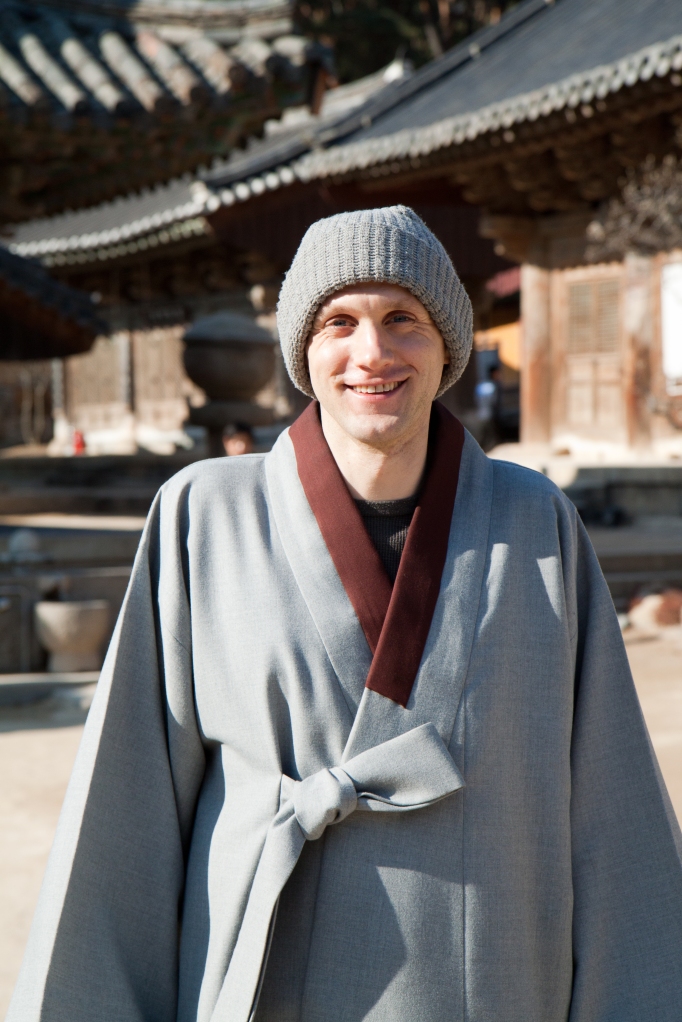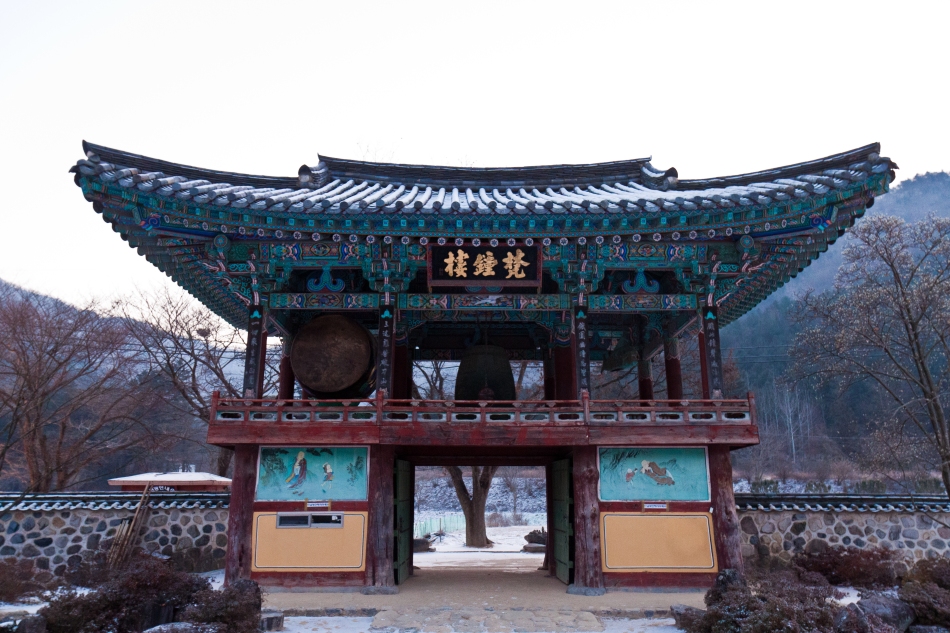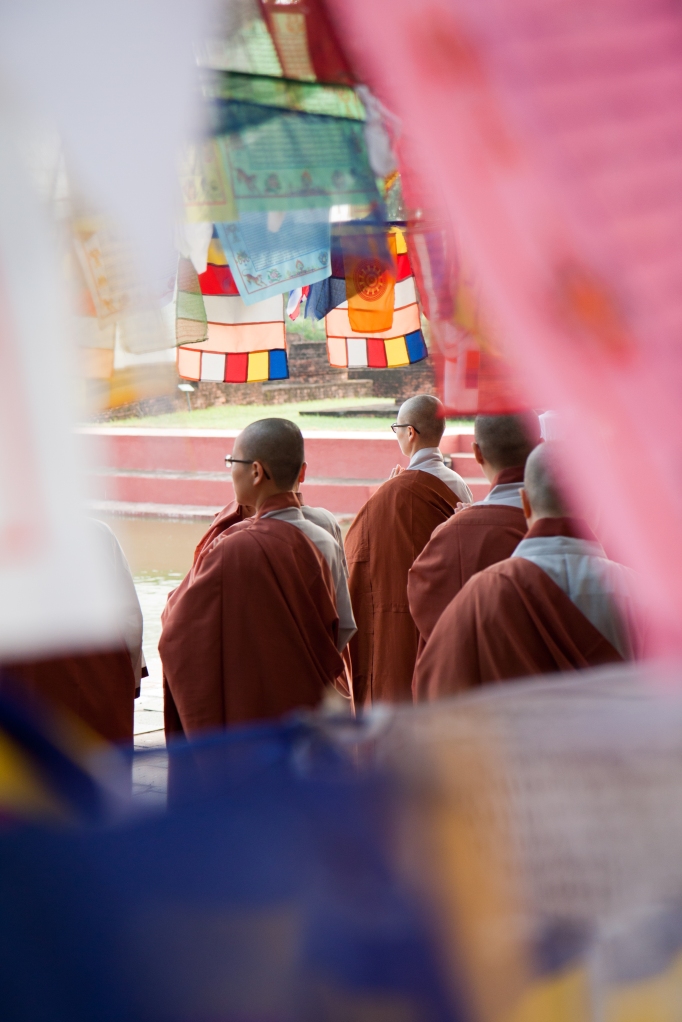tongdo-sa 1.2.2012
 Dok Sang (德上) Sunim, originally from Seattle, WA and currently a first-year student at Tongdo Monastic College
Dok Sang (德上) Sunim, originally from Seattle, WA and currently a first-year student at Tongdo Monastic College
Despite the first snow of the year—which closed Unmun Pass, between Cheong-do and Ulsan—I made it “over the mountain” today to visit Tongdo-sa. Tongdo-sa is not only one the Three Jewel temples in Korea, known as the “Buddha Jewel Temple” because it houses Sakyamuni Buddha’s relics, it is not merely one of the largest temple complexes in the country, it is not simply a well-known full-training temple for monks: it also has four of our novice monks from the international sangha. I met up with two of them today before having tea with the Head of Lecturers of their seminary. Unfortunately, I could only talk Dok Sang Sunim, above, into a picture. His older brother, Dok Jang Sunim, firmly refused to have his portrait taken, alas.
Tongdo-sa is what’s known as a “full training monastery,” or cheong-lim. For those who read Chinese, the characters are below as inscribed on the stone pillar marking one of the boundaries of the temple complex. Chinese readers will also notice the formal name for the temple in its function as a training monastery, Yeong Chuk Full Training Monastery (yeong-chuk cheong-lim). Yeong-chuk is both the name of the mountain on which Tongdo-sa is located as well as the Sino-Korean for Vulture Peak Mountain (Rajgir). In order to qualify as a cheong-lim, a temple complex must have a seminary; a graduate seminary; and a seon bang or Zen hall associated with it. In addition to having all of these, Tongdo-sa is also a large, bustling complex with a labyrinthine layout of side-altars arranged around the temple’s central focus: the bell-shaped stupa housing the Buddha’s relics.
Tongdo-sa is one of my favorite temples in Korea. I first visited Tongdo-sa nearly 8 years ago, when I was a lay-woman and traveling around Korea visiting temples; I spent the night at Naewon-sa, a bhikkuni seon bang, and caught a ride to Tongdo-sa the next morning with two of the Naewon-sa nuns heading there on business. It was spring. The currently naked cherry blossom trees lining the long main avenue leading up from the lower entrance gate were then in their full glory. Today, sunlight filtering through the pines and glinting on the ice clinging to the edges of the stream flowing down from the mountain caught my attention. And instead of the anticipatory trepidation of entering an unknown temple complex, wondering what it might be like, feel like, today I felt the easy anticipation of walking toward a friend’s house.
 Stone pillar inscribed with the full training monastery’s name
Stone pillar inscribed with the full training monastery’s name
I met all the international monks enrolled Tongdo-sa this past summer, when we gathered for the annual foreign monastics’ forum. I was amazed by their diversity: one Czech, one Nepali, one Chinese, one American. A Japanese monk graduated several years earlier. Of course, I always appreciate meeting other Western monastics, because I get to experience the rare feeling of blending in.
 The front gate of Unmun-sa at 7:20 a.m. Cold. Very cold.
The front gate of Unmun-sa at 7:20 a.m. Cold. Very cold.
Compared to the chill winter landscape I slipped and slid over to get to Unmun-sa Bus Station (and it was due to slick roads that the buses weren’t going over the pass this morning, waiting for the thin sheen of ice to melt), the early afternoon was warm. Cups and cups of tea with Tongdo-sa’s Head of Lecturers along with what was, for me, great conversation about the process of seminary life and the education system for the sangha, followed by a little time with two doban before heading over the now-thawed mountain road: a good day.
lumbini, 2011
For the celebration of the birth of the Prince of Peace, an image from the birthplace of the Torchbearer of Mankind.*
Merry Christmas, y’all.
May all beings have happiness and its causes!
May all beings be free from suffering and its causes!
May all beings abide in equanimity, free from the extremes
of aversion and attachment!
May all attain awakening, the sweetest bliss!
*Ukkadharo manussanam, an epithet of the Buddha
momento mori
Myo Eom Sunim (1931-2011), the founder and current Head of one of the Jogye Order of Korean Buddhism’s four traditional seminaries for nuns (called “gangwon,” literally “the lecture hall”) passed away December 12.
Myo Eom Sunim was one of the luminaries of the modern sangha. The daughter of Cheong Dam Sunim, a leader in the bhikku sangha,* she was also among the first bhikkunis to receive official transmission to teach the sutras and was the first nun to serve as a lecturer on the sutras, at Donghak Monastic College. She served as the first Head of Lecturers at Unmun Monastic college with Myeong Seong Sunim as the Head of the School before going on to found her own seminary, Bongnyeong Monastic College, in Suwon. She later established the Geumgang School of Vinaya, the first graduate seminary program in monastic regulations for bhikkunis. Indeed, both Myo Eom Sunim and Bongnyeong-sa are known for their adherence to the Vinaya, and part of Myo Eom Sunim’s unique legacy to our sangha was her emphasis on the monastic discipline as a necessary component of both sutra study and Seon practice. (She was also the student of the reknowned modern Seon master, Seong Cheol Sunim, and was learned in the three areas of Seon, sutra, and Vinaya.)
Although I never had any personal interaction with her, I owe her a debt of gratitude on behalf of my sisters. Bongnyeong-sa was one of the first two seminaries to admit foreign nuns. Three of my sisters in the Dharma, from Europe and America, graduated from Bongnyeong-sa; a fourth is a second-year student there now. By opening the doors of her college to foreign nuns, she made our education in the sutras, monastic regulation, and community life possible. When one family of foreign nuns was in difficulty, needing an overseer and a guardian for their temple, Myo Eom Sunim stepped in to offer her support and backing. This alone speaks to her concern and care for her students in general, and our international sangha in particular.
The Sino-Korean word used for someone who has passed away isn’t “death,” but “entered into stillness” or “entered into extinction.” As participant, officiant, and observer at memorial ceremonies, I’ve often reflected that much of the ceremony and ritual we perform on behalf of the departed is just as intended for us, who have life and time remaining, as for those who have died. To say someone has “entered into stillness” becomes a reminder that the most important dialectic isn’t the one of material life and death but the one of entanglement and liberation (“stillness” and “extinction” being synonyms for release or awakening, as characteristics of “suchness”). To go and bow to the memorial altar, as the senior nuns and fourth-year class of my seminary did, is to honor the mutual relationship between teachers and students. We do not passively learn: we must digest and actualize what she taught to fully honor the relationship and pay back in part the debt of gratitude we owe to our teachers. The teaching-poems that form much of the beautiful liturgy of the cremation and memorial ceremonies are ostensibly spoken directly to the departed; but the living listen too, and there is just as much, if not more, for us to receive and put into practice, we who have not yet entered into stillness.
After bowing to Myo Eom Sunim’s picture on the memorial altar, we bowed to her gathered students, who were standing without kasa to the left of the altar. After a brief tea break, we then returned to recite as a group the Diamond Sutra. Myo Eom Sunim is the first of her generation of pioneering bhikkunis—the generation that established an independent line of sutra transmission for nuns, promoted the study of the bhikkuni Vinaya and the re-establishment of the “double-platform” for bhikkuni ordination, who became participants in the global Buddhist dialogue on women in the Dharma—to pass away. Our senior-most nuns openly wept in front of her altar, directly addressing the nun who was both teacher and friend, both leader and partner, in the work of their lives; it is impossible not to see myself in either position, as the picture on the altar (already gone), or the one standing before it, proving with sorrow the blessing that our teachers and friends are. The image unsettled me then and unsettles me now as I write this, the necessary reminder that death is certain and that it is only what we have done, as of now, that stands us good when we go.
Namu Amitabul.
Korean language article from The Choson Ilbo here and from The Seoul Newspaper here.
*A number of prominent monks of the 20th century entered the monastic order after marriage and children. The children of these monks, especially the daughters, who followed them into the order often became leaders in their own right.


